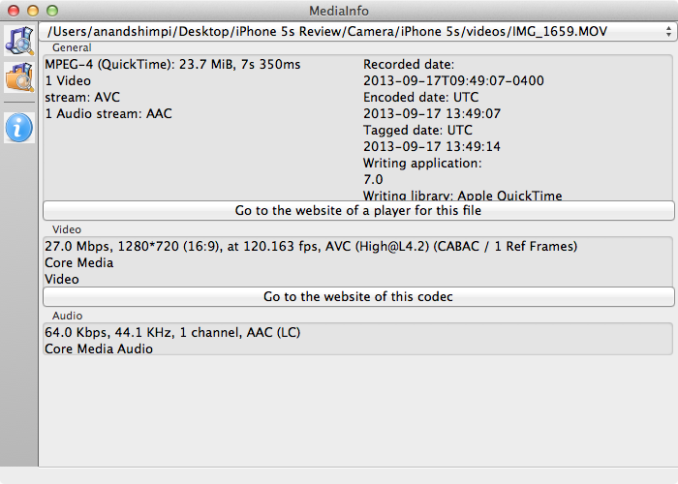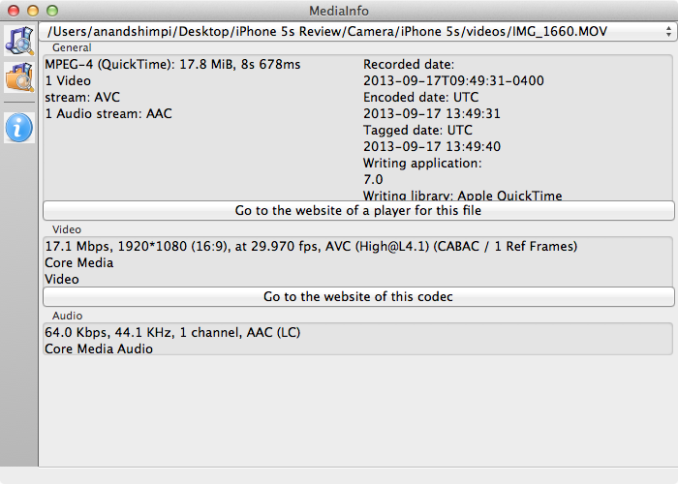The iPhone 5s Review
by Anand Lal Shimpi on September 17, 2013 9:01 PM EST- Posted in
- Smartphones
- Apple
- Mobile
- iPhone
- iPhone 5S
Video
Apple’s new H6 ISP brings with it a modernization of the video recording options for the iPhone 5s. The default video record mode is still 1080p at 30 fps, but there’s also a new 720p 120 fps “slo-mo” mode as well. In the latter, video is captured at 120 fps but optionally played back at 30 fps in order to achieve a high speed camera/slow motion effect. The result is pretty cool:
In the camera UI you can select what portions of the video you want to play back at 30 fps and what portions you want to leave at full speed. The .mov file is stored on NAND as a ~27Mbps 720p120 without any customizations, however when you share it the entire video is transcoded into a 30 fps format which preserves the slow motion effect.
The slo-mo mode is separate from the standard video recording mode, it’s the next stop on the dial in the new iOS 7 camera app. Video preview in slo-mo mode also happens at 60 fps compared to 30 fps for the standard video record and still image capture modes.
 Camera preview frame rate, toggling between slo-mo and normal modes
Camera preview frame rate, toggling between slo-mo and normal modes
Adding high speed camera modes to smartphones is a great step in my opinion and a wonderful use of increases in ISP and SoC performance. I would like to see Apple expose a 1080p60 mode as well. Technically 1080p60 does require slightly more bandwidth than 720p120, but I’d hope that Apple targeted both in the design of H6 and simply chose to expose 720p120 as it’s an easier feature to market.
Standard 1080p30 recording is also available:













464 Comments
View All Comments
Dug - Wednesday, September 18, 2013 - link
"maybe you should hire a developer to write native cross platform benchmark tools"WHY? It is not going to make any difference. Developers aren't writing native cross platform programs. If they can take advantage of anything that's in the system, then show it off.
That would be like telling car manufacturers to redesign a hybrid to gas only to compare with all the other gas only cars.
ddriver - Wednesday, September 18, 2013 - link
"Developers aren't writing native cross platform programs"Maybe it is about time you crawl from under the rock you are living under... Any even remotely concerned with performance and efficiency application pretty much mandates it is a native application. It would be incredibly stupid to not do it, considering the "closest" to native language Java is like 2-3 times slower and users 10-20 times as much memory.
Dug - Wednesday, September 18, 2013 - link
Exactly my point! "native cross platform" Each cross-platform solution can only support a subset of the functionality included in each native platform.It doesn't get you anywhere to produce a native cross platform benchmark tool.
Again you have to mitigate to names and snide comments because you are wrong.
ddriver - Wednesday, September 18, 2013 - link
What you talk about is I/O, events and stuff like that. When it comes to pure number crunching the same code can execute perfectly well for every platform it is complied against. Actually, some modern frameworks go even further than that and provide ample abstractions. For example, the same GUI application can run on Windows, Linux, MacOS, iOS and Android, apart from a few other minor platforms.Anand Lal Shimpi - Wednesday, September 18, 2013 - link
Ultimately the benchmarking problem is being fixed, just not on the time scale that we want it to. I figured we'd be better off by now, and in many ways we are (WebXPRT, Browsermark are both steps in the right direction, we have more native tools under Android now) but part of the problem is there was a long period of uncertainty around what OSes would prevail. Now that question is finally being answered and we're seeing some real investment in benchmarks. Trust me, I tried to do a lot behind the scenes over the past 4 years (some of which Brian and I did recently) but this stuff takes time. I remember going through this in the early days of the PC industry too though, I know how it all ends - it'll just take a little time to get there.Actually I think 128-bit registers might've been optional on v7.
The only reason encryption results are in that table is because that's how Geekbench groups them. There's no nefarious purpose there (note that it's how we've always reported the Geekbench results, as they are reported in the test themselves).
In my experience with the 5s I haven't noticed any performance regressions compared to the 5/5c. I'm not saying they don't exist and I'll continue to hunt, it's just that they aren't there now. I believe I established the reasoning for why you'd want to do this early, and again we're talking about at most 12 months before they should start the move to 64-bit anyways. Apple tends to like its ISA transitions to be as quick and painless as possible, and moving early to ARMv8 makes a lot of sense in that light. Sure they are benefiting from the marketing benefits of having a feature that no one else does, but what company doesn't do that?
I don't believe the move to 64-bit with Cyclone was driven first and foremost by marketing. Keep in mind that this architecture was designed when a bunch of certain ex-AMDers were over there too...
Take care,
Anand
BrooksT - Wednesday, September 18, 2013 - link
Why would Anand write cross-platform benchmarks that have no connection to real world usage? Especially when you then complain that the 64 bit coverage isn't real world enough?ddriver - Wednesday, September 18, 2013 - link
For starters, putting the encryption results in their own graph, like every other review before that, and side to side comparison between geekbench ST/MT scores for A7 and competing v7 chips would be a good start toward a more objective and less biased article.And I know I am asking a lot, but an edit feature in the comment section is long overdue...
TheBretz - Wednesday, September 18, 2013 - link
For what it's worth this is NOT a case of LITERALLY comparing "Apples" and "Oranges" - it is a case of comparing "Apple" and many other manufacturers, but there was no fruit involved in the comparison, only smarthphones and tablets.ddriver - Wednesday, September 18, 2013 - link
Apples to oranges is a figure of speech, it has nothing to do with the company apple... It concerns comparing incomparable objects which is the case of completely different JS implementations on iOS and Android.Arbee - Wednesday, September 18, 2013 - link
Please name any case when AT's benchmarks and reviews have been proven to be biased or inaccurate. There's a reason the writers at other sites consider AT the gold standard for solid technical commentary (Engadget, Gizmodo, and the Verge all regularly credit AT on technical stories). As far as bias, have you *heard* Brian cooing about practically wanting to marry the Nexus 5? ;-)I think what actually happened here is that apparently Apple engineers listen to the AT podcast, because aside from 802.11ac and the screen size the 5S is designed almost perfectly to AT's well-known and often-stated specifications. It hits all of Anand's chip architecture geekery hot buttons in a way that Samsung's mashups of off-the-shelf parts never will, and they used Brian's exact line "Bigger pixels means better pictures" in the presentation. And naturally, if someone gives you what you want, you're likely to be happy with it. This is why people have Amazon gift lists ;-)
Krait's 128 bit SIMD definitely helps, but it won't match true v8 architecture designs. I've written commercially shipping ARM assembly, and there's a *lot* of cruft in the older ISA that v8 cleans right up. And it lets compilers generate *much* more favorable code. I'll be surprised if the next Snapdragons aren't at least 32-bit v8. Qualcomm has been pretty forward-looking aside from their refusal to cooperate with the open-source community (Freedreno FTW).
As far as 64 bit on less than 4 GB of RAM, it enables applications to more freely operate on files in NAND without taking up huge amounts of RAM (via mmap(), which the Linux kernel in Android of course also has). Apps like Loopy HD and MultiTrack DAW (not to mention Apple's own iMovie and GarageBand) will definitely be able to take advantage.